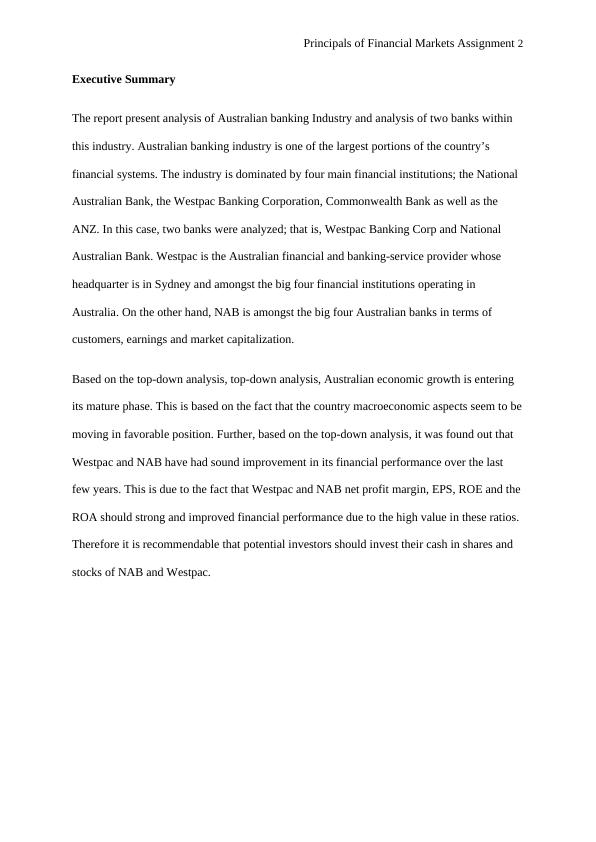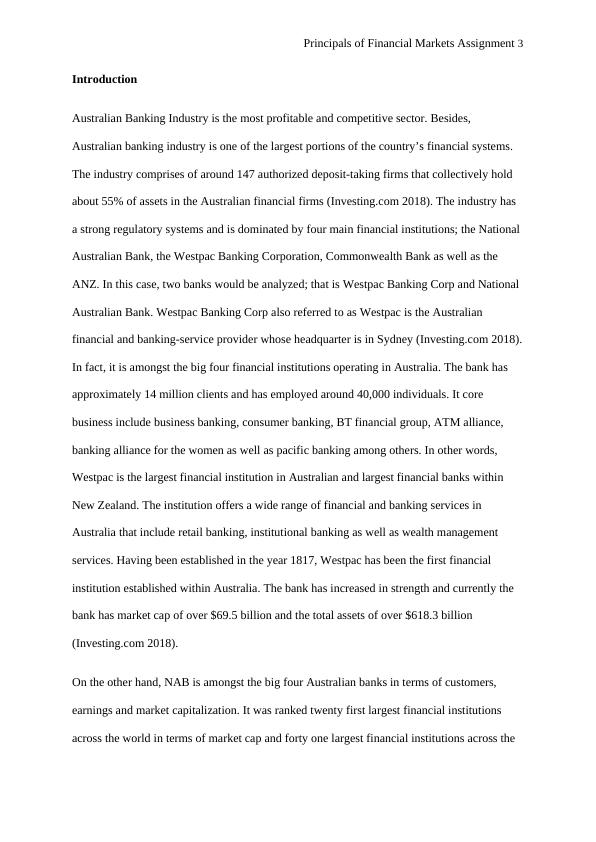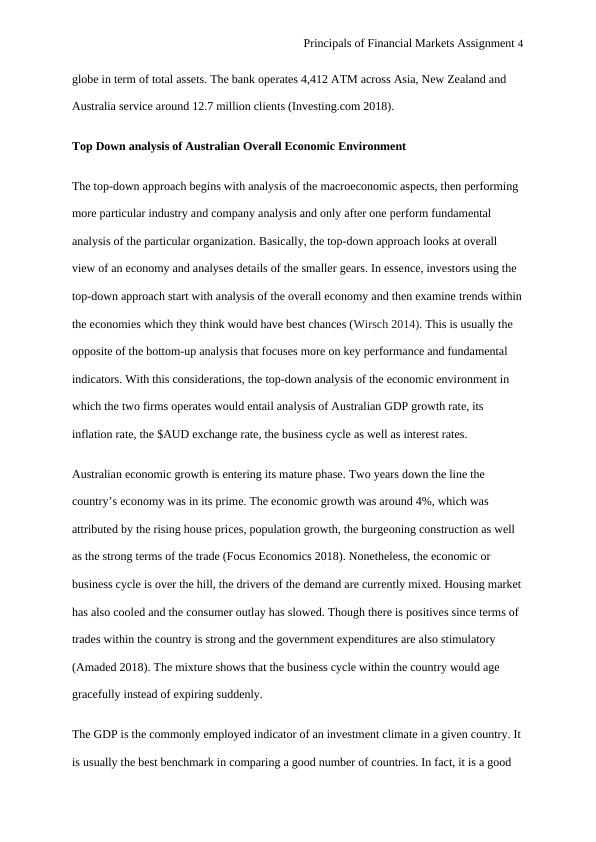Analysis of Australian Banking Industry and Two Banks: NAB and Westpac
Added on 2023-06-04
12 Pages3580 Words437 Views
Principals of Financial Markets Assignment 1
PRINCIPALS OF FINANCIAL MARKETS ASSIGNMENT
Author
Course
Professor
City
Date
PRINCIPALS OF FINANCIAL MARKETS ASSIGNMENT
Author
Course
Professor
City
Date

Principals of Financial Markets Assignment 2
Executive Summary
The report present analysis of Australian banking Industry and analysis of two banks within
this industry. Australian banking industry is one of the largest portions of the country’s
financial systems. The industry is dominated by four main financial institutions; the National
Australian Bank, the Westpac Banking Corporation, Commonwealth Bank as well as the
ANZ. In this case, two banks were analyzed; that is, Westpac Banking Corp and National
Australian Bank. Westpac is the Australian financial and banking-service provider whose
headquarter is in Sydney and amongst the big four financial institutions operating in
Australia. On the other hand, NAB is amongst the big four Australian banks in terms of
customers, earnings and market capitalization.
Based on the top-down analysis, top-down analysis, Australian economic growth is entering
its mature phase. This is based on the fact that the country macroeconomic aspects seem to be
moving in favorable position. Further, based on the top-down analysis, it was found out that
Westpac and NAB have had sound improvement in its financial performance over the last
few years. This is due to the fact that Westpac and NAB net profit margin, EPS, ROE and the
ROA should strong and improved financial performance due to the high value in these ratios.
Therefore it is recommendable that potential investors should invest their cash in shares and
stocks of NAB and Westpac.
Executive Summary
The report present analysis of Australian banking Industry and analysis of two banks within
this industry. Australian banking industry is one of the largest portions of the country’s
financial systems. The industry is dominated by four main financial institutions; the National
Australian Bank, the Westpac Banking Corporation, Commonwealth Bank as well as the
ANZ. In this case, two banks were analyzed; that is, Westpac Banking Corp and National
Australian Bank. Westpac is the Australian financial and banking-service provider whose
headquarter is in Sydney and amongst the big four financial institutions operating in
Australia. On the other hand, NAB is amongst the big four Australian banks in terms of
customers, earnings and market capitalization.
Based on the top-down analysis, top-down analysis, Australian economic growth is entering
its mature phase. This is based on the fact that the country macroeconomic aspects seem to be
moving in favorable position. Further, based on the top-down analysis, it was found out that
Westpac and NAB have had sound improvement in its financial performance over the last
few years. This is due to the fact that Westpac and NAB net profit margin, EPS, ROE and the
ROA should strong and improved financial performance due to the high value in these ratios.
Therefore it is recommendable that potential investors should invest their cash in shares and
stocks of NAB and Westpac.

Principals of Financial Markets Assignment 3
Introduction
Australian Banking Industry is the most profitable and competitive sector. Besides,
Australian banking industry is one of the largest portions of the country’s financial systems.
The industry comprises of around 147 authorized deposit-taking firms that collectively hold
about 55% of assets in the Australian financial firms (Investing.com 2018). The industry has
a strong regulatory systems and is dominated by four main financial institutions; the National
Australian Bank, the Westpac Banking Corporation, Commonwealth Bank as well as the
ANZ. In this case, two banks would be analyzed; that is Westpac Banking Corp and National
Australian Bank. Westpac Banking Corp also referred to as Westpac is the Australian
financial and banking-service provider whose headquarter is in Sydney (Investing.com 2018).
In fact, it is amongst the big four financial institutions operating in Australia. The bank has
approximately 14 million clients and has employed around 40,000 individuals. It core
business include business banking, consumer banking, BT financial group, ATM alliance,
banking alliance for the women as well as pacific banking among others. In other words,
Westpac is the largest financial institution in Australian and largest financial banks within
New Zealand. The institution offers a wide range of financial and banking services in
Australia that include retail banking, institutional banking as well as wealth management
services. Having been established in the year 1817, Westpac has been the first financial
institution established within Australia. The bank has increased in strength and currently the
bank has market cap of over $69.5 billion and the total assets of over $618.3 billion
(Investing.com 2018).
On the other hand, NAB is amongst the big four Australian banks in terms of customers,
earnings and market capitalization. It was ranked twenty first largest financial institutions
across the world in terms of market cap and forty one largest financial institutions across the
Introduction
Australian Banking Industry is the most profitable and competitive sector. Besides,
Australian banking industry is one of the largest portions of the country’s financial systems.
The industry comprises of around 147 authorized deposit-taking firms that collectively hold
about 55% of assets in the Australian financial firms (Investing.com 2018). The industry has
a strong regulatory systems and is dominated by four main financial institutions; the National
Australian Bank, the Westpac Banking Corporation, Commonwealth Bank as well as the
ANZ. In this case, two banks would be analyzed; that is Westpac Banking Corp and National
Australian Bank. Westpac Banking Corp also referred to as Westpac is the Australian
financial and banking-service provider whose headquarter is in Sydney (Investing.com 2018).
In fact, it is amongst the big four financial institutions operating in Australia. The bank has
approximately 14 million clients and has employed around 40,000 individuals. It core
business include business banking, consumer banking, BT financial group, ATM alliance,
banking alliance for the women as well as pacific banking among others. In other words,
Westpac is the largest financial institution in Australian and largest financial banks within
New Zealand. The institution offers a wide range of financial and banking services in
Australia that include retail banking, institutional banking as well as wealth management
services. Having been established in the year 1817, Westpac has been the first financial
institution established within Australia. The bank has increased in strength and currently the
bank has market cap of over $69.5 billion and the total assets of over $618.3 billion
(Investing.com 2018).
On the other hand, NAB is amongst the big four Australian banks in terms of customers,
earnings and market capitalization. It was ranked twenty first largest financial institutions
across the world in terms of market cap and forty one largest financial institutions across the

Principals of Financial Markets Assignment 4
globe in term of total assets. The bank operates 4,412 ATM across Asia, New Zealand and
Australia service around 12.7 million clients (Investing.com 2018).
Top Down analysis of Australian Overall Economic Environment
The top-down approach begins with analysis of the macroeconomic aspects, then performing
more particular industry and company analysis and only after one perform fundamental
analysis of the particular organization. Basically, the top-down approach looks at overall
view of an economy and analyses details of the smaller gears. In essence, investors using the
top-down approach start with analysis of the overall economy and then examine trends within
the economies which they think would have best chances (Wirsch 2014). This is usually the
opposite of the bottom-up analysis that focuses more on key performance and fundamental
indicators. With this considerations, the top-down analysis of the economic environment in
which the two firms operates would entail analysis of Australian GDP growth rate, its
inflation rate, the $AUD exchange rate, the business cycle as well as interest rates.
Australian economic growth is entering its mature phase. Two years down the line the
country’s economy was in its prime. The economic growth was around 4%, which was
attributed by the rising house prices, population growth, the burgeoning construction as well
as the strong terms of the trade (Focus Economics 2018). Nonetheless, the economic or
business cycle is over the hill, the drivers of the demand are currently mixed. Housing market
has also cooled and the consumer outlay has slowed. Though there is positives since terms of
trades within the country is strong and the government expenditures are also stimulatory
(Amaded 2018). The mixture shows that the business cycle within the country would age
gracefully instead of expiring suddenly.
The GDP is the commonly employed indicator of an investment climate in a given country. It
is usually the best benchmark in comparing a good number of countries. In fact, it is a good
globe in term of total assets. The bank operates 4,412 ATM across Asia, New Zealand and
Australia service around 12.7 million clients (Investing.com 2018).
Top Down analysis of Australian Overall Economic Environment
The top-down approach begins with analysis of the macroeconomic aspects, then performing
more particular industry and company analysis and only after one perform fundamental
analysis of the particular organization. Basically, the top-down approach looks at overall
view of an economy and analyses details of the smaller gears. In essence, investors using the
top-down approach start with analysis of the overall economy and then examine trends within
the economies which they think would have best chances (Wirsch 2014). This is usually the
opposite of the bottom-up analysis that focuses more on key performance and fundamental
indicators. With this considerations, the top-down analysis of the economic environment in
which the two firms operates would entail analysis of Australian GDP growth rate, its
inflation rate, the $AUD exchange rate, the business cycle as well as interest rates.
Australian economic growth is entering its mature phase. Two years down the line the
country’s economy was in its prime. The economic growth was around 4%, which was
attributed by the rising house prices, population growth, the burgeoning construction as well
as the strong terms of the trade (Focus Economics 2018). Nonetheless, the economic or
business cycle is over the hill, the drivers of the demand are currently mixed. Housing market
has also cooled and the consumer outlay has slowed. Though there is positives since terms of
trades within the country is strong and the government expenditures are also stimulatory
(Amaded 2018). The mixture shows that the business cycle within the country would age
gracefully instead of expiring suddenly.
The GDP is the commonly employed indicator of an investment climate in a given country. It
is usually the best benchmark in comparing a good number of countries. In fact, it is a good

End of preview
Want to access all the pages? Upload your documents or become a member.
Related Documents
Analysis of ANZ and Commonwealth Banks in the Australian Banking Sectorlg...
|11
|2869
|135
Analysis of ANZ and BOQ Financial Performance in Australian Banking Industrylg...
|15
|3600
|316
Analysis of Australian Banking Sector: A Comparison of Bank of Queensland and Westpac Banking Corplg...
|16
|3741
|481
Evaluating Financial Management Strategies of Top Australian Bankslg...
|4
|624
|304
Corporate Accounting Assignment: Analysis of Westpac Banking Corp and NABlg...
|23
|4291
|311
Banking And Finance Assesment Reportlg...
|14
|3475
|10